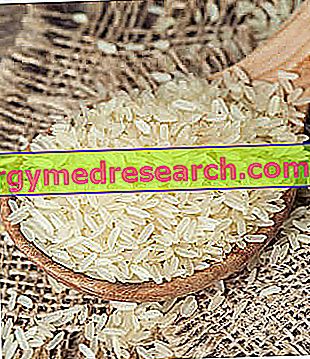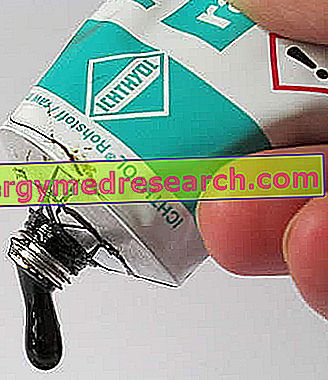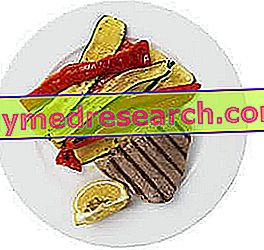Generality
Parboiled rice - also known as converted rice - is a food product derived from the edible seeds of the Oryza sativa cereal. It is therefore not a specific variety of rice, but a processing method that can be applied to different types of rice.

The three basic steps of "parboiling" are:
- soak in hot water;
- steam cooking at high temperature and under pressure;
- drying (drying).
These steps make the parboiled:
- easily workable (it hardens the individual grains, facilitates the removal of the husk and reduces the quantity of broken grains during husking and husking);
- more rich from a nutritional point of view;
- more storable;
- more resistant to cooking (it can be cooked for a long time without disintegrating).
About 50% of world rice production is conveyed to the production of parboiled rice; in fact, this treatment is applied in many countries of the world such as: India, Bangladesh, Pakistan, Myanmar, Malaysia, Nepal, Sri Lanka, Guinea, South Africa, Italy, Spain, Nigeria, Thailand, Switzerland, the United States and France.
The name parboiled derives from the partially boiled English, partially boiled
Loans
The most significant characteristic of parboiled rice concerns the structure of the starch, which during soaking and steaming tends to gelatinize, and then regress with cooling.
With gelatinization, the amylose molecules exit the granular complex of the starch and partially dissolve in the surrounding aqueous medium. When the starch is hydrated it completely gelatinizes and reaches the maximum viscosity becoming translucent.
The cooling involves the demotion of the process, in which the amylose molecules reassociate with each other and form a compact structure on the surface. This phase increases the formation of type 3 resistant starch, which tolerates heat better and has prebiotic functions. The seeds, therefore, require a faster cooking, release less starch and maintain a harder and "glassy" consistency.
- The parboiled resists very well to prolonged cooking (not overcook).
- It cooks quickly and can be cooked in advance and stored in the fridge without losing its characteristics.
- It is particularly suitable for salads, but it is also very popular for preparing dry rice, such as tomatoes.
Nutritional advantages
Parboiling appears to have the ability to partially convey the nutritional molecules from the bran to the endosperm (especially vitamin B1 or thiamine), making its nutritional spectrum much more similar to brown rice (obviously, with less fiber). Furthermore, due to the greater consistency of its surface, a parboiled rice grain releases less nutrients into the cooking water.
Thanks to this nutritional improvement, parboiled rice has been produced in North America since the early 20th century. On the same continent, the product is available with various levels of pre-cooking and also exists in versions fortified with certain minerals such as, for example, zinc and iron.
Dietary Features
Parboiled rice is a food that belongs to the III fundamental group of foods.
Being dehydrated, it has a rather high energy intake. Calories are mainly supplied by carbohydrates, followed by proteins and finally lipids (negligible). The carbohydrates tend to be complex, the peptides have a medium biological value and the few fatty acids are above all unsaturated.
Cholesterol is absent and the fibers, which tend to be insoluble, do not show themselves too abundant.
From the saline point of view, parboiled rice uses a good content of iron and phosphorus, but there is no lack of discrete concentrations of microelements. As for the vitamins, the most present is the water-soluble B1 (thiamine).
Parboiled rice does not contain gluten and lactose, which is why it is suitable for the diet due to its intolerances. It is granted in vegetarian and vegan diets, but not in raw food.
Its presence in the diet is to be alternated with other cereals but, overall, the III fundamental group of foods should be part of the daily diet. The portions must be more contained for obese subjects, for diabetic or hyperglycemic subjects and for those suffering from hypertriglyceridemia.
The average portion of parboiled rice is about 70-90g dry weighed.
To better highlight the chemical differences between common polished rice and parboiled, below we expose the chemical detail of both foods.
| Chemical composition | Value for 100g | ||
| Shiny Rice | Parboiled Rice | ||
| Edible part | 100% | 100% | |
| water | 12, 0g | 10, 3g | |
| Protein | 6, 7g | 7, 4g | |
| Limiting Amino Acid | Lysine | Lysine | |
| Total lipids | 0.4g | 0.3g | |
| Saturated fatty acids | 0, 10g | - | |
| Monounsaturated fatty acids | 0, 13g | - | |
| Polyunsaturated fatty acids | 0, 18g | - | |
| Cholesterol | 0, 0mg | 0, 0mg | |
| Carbohydrates available | 80, 4g | 81, 3g | |
| Starch | 72, 9g | 73, 6g | |
| Soluble sugars | 0.2g | 0.3g | |
| Total fiber | 1.0g | 0.5g | |
| Soluble fiber | 0, 08g | - | |
| Insoluble fiber | 0, 89g | - | |
| Phytic acid | - | - | |
| Alcohol | 0.0g | 0.0g | |
| Power | 332, 0kcal | 337, 0kcal | |
| Sodium | 5, 0mg | 9, 0mg | |
| Potassium | 92, 0mg | 150, 0mg | |
| Iron | 0, 8mg | 2, 9mg | |
| Football | 24, 0mg | 60, 0mg | |
| Phosphorus | 94, 0mg | 200, 0mg | |
| Magnesium | 20, 0mg | - | |
| Zinc | 1, 3mg | 2, 0mg | |
| Copper | 0, 18mg | 0, 34mg | |
| Selenium | 10, 0μg | 14, 0μg | |
| Thiamine | 0, 11mg | 0, 34mg | |
| Riboflavin | 0, 03mg | - | |
| Niacin | 1, 3mg | - | |
| Vitamin A retinol eq. | 0, 0μg | 0, 0μg | |
| C vitamin | 0, 0mg | 0, 0mg | |
| Vitamin E | tr | tr | |
As can be clearly seen from the table, the substantial difference between parboiled and polished rice is in the salt and vitamin profile.
Potassium, iron, calcium, phosphorus, zinc, copper, selenium and vitamin B1 are the nutrients that abound most in parboiled compared to polished rice.
Evolution of the Production Method
The oldest production methods involved soaking the clean paddy in cold water for 36-38 hours, so that the humidity could reach 30-35%; subsequently, it was placed in the parboiling equipment with cold water and boiled until the bran was separated. It was then subjected to cooling, drying and processing.
In 1910, the German-British scientist Erich Gustav Huzenlaub (1899-1964) and the English chemist Francis Heron Rogers invented a technique capable of preserving the nutritional content of the seeds and making them more resistant to insects belonging to the Curculionidae family. This process is called Huzenlaub and includes:
- Vacuum drying of dry and still whole seeds
- Vacuum steam cooking
- Vacuum drying
- Refining process (hulling).
In the improved methods subsequently, it is foreseen the imbibing of the rice in hot water and the steam cooking by boiling, which requires only 3 hours rather than the 20 of the traditional systems and gives the rice a yellowish color and greater resistance during processing.
Depending on the duration of the steam cooking during the production process, parboiled rice is obtained which requires different cooking times: from 16-19 minutes for those with limited heat treatment, up to 5-10 minutes for parboiled rice undergoing cooking at prolonged steam.


